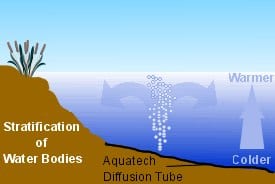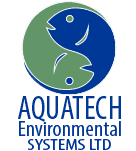Thermal and Chemical De-stratification of Lakes and Ponds
What is stratification:
Vertical temperature stratification that shows the following: The upper layer of the lake, known as the epilimnion, in which the water temperature is virtually uniform; a stratum next below, known as the thermocline, in which there is a marked drop in temperature per unit of depth; and the lowermost region or stratum, known as the hypolimnion, in which the temperature from its upper limit to the bottom is nearly uniform. (Welch, 1952, p. 51.)
Stratification can lead to the development of toxic algal blooms and the general deterioration of water quality in the water body.
Preventing Stratification:
Diffused aeration is the ideal means of preventing thermal stratification and high surface water temperatures in pond culture systems. Diffused aeration is also an ideal technique for preventing stratification of lakes and reservoirs.
Simple aeration at the deepest part of the lake has been shown to be very effective at de-stratifying very large lakes. The process is remarkable by the fact that a small amount of aeration at one spot in a lake can have such a tremendous impact on water quality over the entire lake.
The amount of water physically moved by the process will depend on the amount of air diffused into the water and the depth at which the diffusers are placed. However as a rule of thumb guide, if the diffusers were at a depth of 30 metres, then for every cubic metre of air passed through the diffuser in one hour, approximately 200 cubic metres of water will be moved from the diffuser to the surface.

Destratification and Aquaculture
Diffused aeration/de-stratification below freshwater trout or smolt cages will help disperse waste feed and feces and help the natural process of bacterial degradation of the matter. Feed conversion efficiency by the fish should also improve along with a reduction in disease incidents and improved water quality. See more about Aquatech’s Oxygem System

